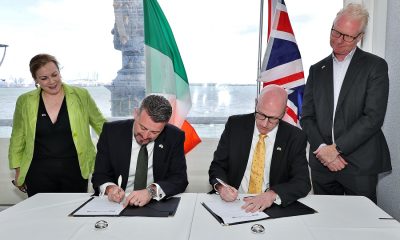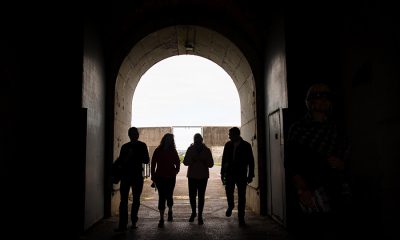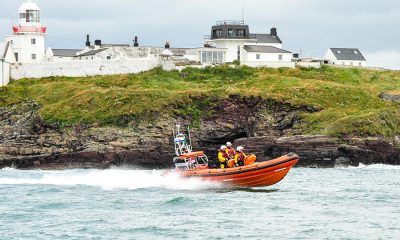Local News
Lusitania Commemoration and Lecture: Sun 9th May
- Share
- Tweet /home/eastcork/public_html/wdir/wp-content/plugins/mvp-social-buttons/mvp-social-buttons.php on line 68
https://www.cobhedition.com/wdir/wp-content/uploads/2010/04/lucy5.jpg&description=Lusitania Commemoration and Lecture: Sun 9th May', 'pinterestShare', 'width=750,height=350'); return false;" title="Pin This Post">
Lusitania Tragedy to be remembered in Cobh
The commemoration of the 95th Anniversary of the sinking of the Lusitania will take place in Cobh on Sunday 9th May. Organised by Cobh Tourism the ceremonies are fitting memorials to all those who lost their lives on that fateful war time voyage.
The ceremony commences at the Lusitania graves in the Old Church Cemetery just outside Cobh at 2pm. Following prayers, musical honours by St. Colman´s Pipe Band and the laying of wreaths, the proceedings move to Cobh Town Centre. A Parade led by a Colour Party from the O.N.E. and representatives of the Royal Naval Association and other maritime and historical groups will leave from the Old Town Hall on Lynch´s Quay at 2.30pm to the Lusitania Peace Memorial in Casement Square.
Further ceremonies will take place here including a wreath laying ceremony.
A Public lecture entitled *Exploring the Lusitania* will be held at 3.30 pm in the Commodore Hotel in Cobh also on Sunday 9th May. Eoin Mc Garry and Timmy Carey are vastly experienced divers and have made several descents to the wreck of the Lusitania. Their presentation will include video footage showing where ammunition and shell casings are on the wreck today. This may suggest that the Lusitania was a legitimate war target. Admission to the lecture is free.
It was on 7th May 1915 that the Cunard liner Lusitania sank after being struck by a torpedo fired by the German Submarine U-20 off the old Head of Kinsale. Of the 1257 passengers and 702 crew on board, more than 1100 people died, including almost a hundred children. With the outbreak of the First World War many ships were requisitioned by the war effort. However Lusitania was considered too large and visible a target and remained in civilian use. In February 1915 Germany declared the waters surrounding the British Isles a “War Zone”. This didn´t mean that all ships were targets of German submarines and efforts were taken to avoid sinking neutral ships.
On May 1, 1915, under the command of Captain William Turner the R.M.S. *Lusitania* left New York on her 202nd crossing of the Atlantic. The German government decided to warn passengers not to sail aboard *Lusitania* before this crossing. A prepaid warning advertisement was placed in fifty East Coast newspapers, including those in New York. This advertisement was to be put on the paper’s travel page a full week before the sailing date. However the advertisement only appeared in one newspaper, the Des Moines Register.
On May 7th, the Lusitania came into sight of the Irish coast. An Admiralty warning had been issued of submarine activity in the area. Captain Turner heeded this warning and put prudent precautions in place. Watertight doors were closed, double lookouts were posted, a black-out was ordered and the lifeboats were swung out on their davits so they could be quickly put into the water. At around 13.45, the Lusitania was spotted by U-20. A torpedo was fired at 14.09. At 14.10, the German Commander Schwieger noted in his log that Lusitania was hit on the starboard side behind the bridge. A second explosion occurred soon after but the Germans insisted that only one torpedo was launched. The Lusitania started to list immediately and this list complicated the launch of her lifeboats. Of the forty eight lifeboats only six were successfully lowered. Just eighteen minutes later the Lusitania sank.
There was understandable anger throughout America and Great Britain at what was considered an act of brutality. 128 of the passengers and crew who drowned were American. Many consider the sinking of the
Lusitania to be a contributing factor in the United States entering the War.
Among those who died was renowned Irish art collector Sir Hugh Lane and millionaire Alfred Gwynne Vanderbilt. Most of the 764 people who were saved were landed in Cobh. Only 289 bodies were recovered and 169 of these are buried in the Old Church Cemetery in Cobh in three mass graves and 20 individual plots. Forty five of those buried were unidentified and their coffins were merely marked with a number.
– The keel of the *Lusitania* was laid down at the shipyard of John Brown and Company of Clydebank, Scotland on June 16, 1904. She was launched on Thursday, June 7, 1906.
– When Lusitania entered service in 1907 she was the largest and fastest ship in the world.
– In October 1907, *Lusitania* took the Blue Riband from the North German Lloyd* *ship* Kaiser Wilhelm II* .
– Lusitania completed 201 trans-Atlantic voyages.
– The wreck of the Lusitania is owned by American multi-millionaire Greg Bemis Jnr.
– The wreck of the Lusitania has been protected as a national heritage site since 1995 and diving to the wreck requires a permit.
-

 Announcements3 weeks ago
Announcements3 weeks agoJOB OPPORTUNITIES Watersedge Hotel are currently hiring for the following positions
-

 Local News3 weeks ago
Local News3 weeks agoLandmark Partnership: Cruise Ireland and Cruise Britain Join Forces to Boost Cruise Tourism
-

 Events & Entertainment3 weeks ago
Events & Entertainment3 weeks agoSarah Browne Exhibition at the Sirius Arts Centre
-

 Local News2 weeks ago
Local News2 weeks agoSpike Island’s After Dark Tours return: Explore the haunting history of iconic prison island once dubbed “Ireland’s Hell”
-

 Local News4 days ago
Local News4 days agoCrosshaven RNLI Assist Two on Disabled Yacht
-

 Local News4 days ago
Local News4 days agoCyclists of all abilities encouraged to join Fort2Fort Charity Cycle 2024Saturday, 8th June
-

 Announcements4 days ago
Announcements4 days agoCobh Youth & Social Projects CLG have the following vacancies
-

 Events & Entertainment4 days ago
Events & Entertainment4 days agoSIRIUS ARTS CENTRE: COMMISSION: Aikaterini Gegisian
-

 Sport3 days ago
Sport3 days agoJohn O’Shea extended as Interim Head Coach for June window
-

 Local Soccer2 weeks ago
Local Soccer2 weeks agoCobh Wanderers face College Corinthians in 1st Round of Sports Direct Men’s FAI Cup








